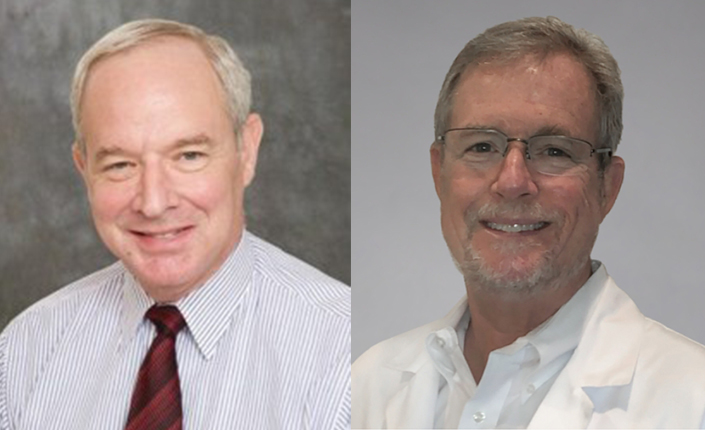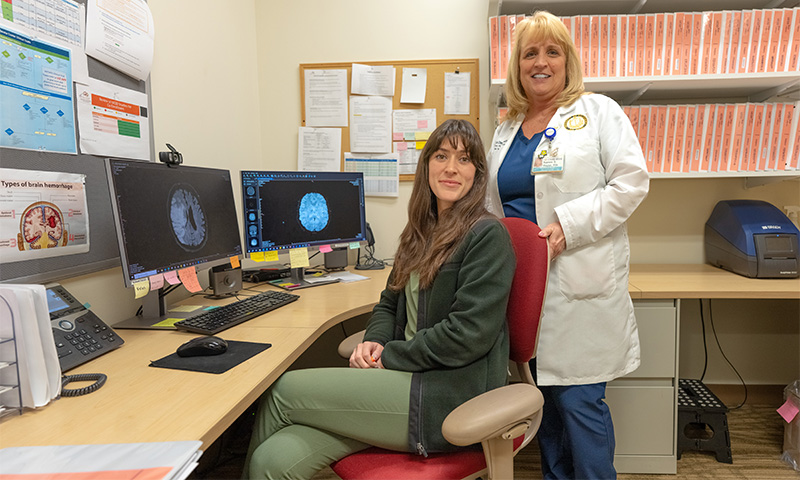From Breakthrough Discovery to Lifesaving Treatment: UC San Diego’s Impact on Stroke Care
University of California San Diego, with the support of the National Institutes of Health, was instrumental in discovering and testing a paradigm-shifting stroke medication.
Published Date
Story by:
Topics covered:
Share This:
Article Content
In 1991, research nurse Karen Rapp was hired by the UC San Diego Stroke Center to oversee a new clinical trial. The goal: to test an intravenous clot-dissolving drug called tissue plasminogen activator (tPA) for patients having a stroke.
“At that time, stroke was the third leading cause of death in the United States, because there were virtually no treatments available,” said Rapp. “Before tPA, all we could do when people came into the emergency room with a stroke, is provide supportive care and hope to avoid complications.”
Every 40 seconds, somebody in the United States has a stroke, which occurs after blood flow to the brain is interrupted by a blood clot. When tPA is administered within three hours after stroke symptoms begin, the drug can dissolve the clot and restore blood flow to the brain, significantly reducing the chance of long-term neurologic injury.
“Clot-dissolving drugs are our first line of defense when somebody presents with a stroke in the hospital,” said Brett C. Meyer, M.D., co-director of the Stroke Center, professor of neurosciences at UC San Diego School of Medicine, and neurologist at UC San Diego Health.

While strokes can still be deadly, the International Journal of Epidemiology reported in 2022 that stroke mortality rates declined by 32% between 1990 and 2017. Medical advances like tPA are a significant contributor to this progress.
“These medications can be the difference between life and death for patients, and it cannot be overstated how much the discovery of tPA transformed stroke care around the world,” added Meyer.
A World-Changing Discovery
UC San Diego played an integral role in bringing tPA for stroke into the hospital setting, and it all starts with the late Justin Zivin, M.D., Ph.D., professor emeritus at UC San Diego School of Medicine. In 1985, Zivin co-authored an article in the journal Science containing a breakthrough finding: that tPA can reduce brain damage in stroke caused by blood clots. Though tPA was already emerging as a promising treatment for heart attack–it would go on to be approved by the FDA for this purpose in 1987—this was the first definitive evidence that it may work for stroke.
While Zivin’s findings had tremendous potential, his experiments were not conducted in humans. To demonstrate the potential of tPA in humans, it would take a randomized controlled clinical trial, the gold standard for testing new treatments and a requirement for FDA approval. In 1991, the National Institute of Neurological Disorders and Stroke (NINDS) within the National Institutes of Health (NIH) kickstarted the first large-scale clinical trial to test tPA in people having a stroke.
The NINDS Stroke Study involved 624 participants and eight medical centers across the country. Of these 624 participants, 146 were treated at UC San Diego Health. Because the trial design required that all participants be treated within three hours and half of these in under 90 minutes, one of the biggest challenges in the trial was simply getting enough people enrolled and treated.
“After a stroke, the patient or a loved one would have to recognize the emergency and call 911, then they would be transported to a facility. The team there would have to identify it as a stroke, and then our team would have to travel to the site, evaluate the patient, perform a CAT scan, obtain consent, and administer the medication,” said Rapp. “That’s a lot to do in under 90 minutes.”
Despite these challenges, Rapp and the research team, led by Patrick Lyden, M.D., former chief of neurology at UC San Diego, persisted. Through long hours and carefully coordinated logistics, they were able to recruit enough participants for the study, and in 1995, the results of the tPA trial were published in the New England Journal of Medicine. This evidence resulted in tPA for stroke receiving FDA approval the following year. Today, the NINDS tPA trial is still regarded as one of the most important studies in the history of stroke care.
“We’ve come a long way in stroke care since tPA was approved, but none of this would have been possible without the initial paradigm shift of tPA,” added Rapp.
Continuing the Legacy

UC San Diego is still at the forefront of stroke science, with researchers exploring new treatments and technologies to improve patient outcomes. One such example is the use of Tenecteplase (TNK), a sister drug to tPA that is just as beneficial, but easier to administer. It has been recently approved by the FDA for use in stroke and now adopted in many hospitals, including at UC San Diego.
The university is also at the cutting-edge of applying telehealth to stroke care. For example, Meyer, who is also clinical director for UC San Diego Telehealth, was the principal investigator for an NIH-funded clinical research trial (STRokE DOC) that assessed whether the use of telemedicine technologies can result in appropriate treatment decisions for acute stroke and assist with administering medications like tPA.
“We’re fortunate to have Comprehensive Stroke Centers at UC San Diego Health, but not all emergency departments have such immediate access to stroke expertise,” said Meyer. “Since there’s only a narrow window where clot-dissolving medications are even effective, telemedicine can expedite these critical treatment decisions.”
UC San Diego is also part of the NIH StrokeNet, a national network of 28 regional coordinating centers designated by the NIH to facilitate clinical trials and improve stroke care. This network has enabled the enrollment of more than 18,000 participants in clinical studies since its inception and allows researchers to expedite clinical trials by sharing resources and expertise.

Despite this progress, the future of stroke research is uncertain due to proposed cuts to NIH funding. Rapp emphasizes that the approval of tPA for stroke would not have happened without the support of NIH, and that stroke research at UC San Diego and around the country continues to rely on these dollars.
“The NIH was pivotal in the success of bringing tPA to stroke patients in emergency settings, and all of the clinical trials we currently do at the Stroke Center are funded by the NIH,” she said. “If NIH funding were cut, our research activities would be significantly impacted,” said Rapp.
While the impact to researchers would be immediate, Rapp warns that the downstream impact of NIH cuts would be much broader.
“The next lifesaving breakthroughs depend on the funding decisions we make today. Protecting NIH research funding is protecting lifesaving treatments for tomorrow’s patients.”
You May Also Like
Neurobiology’s Terrence Sejnowski Elected to Royal Society and American Philosophical Society
Health & BehaviorStay in the Know
Keep up with all the latest from UC San Diego. Subscribe to the newsletter today.



